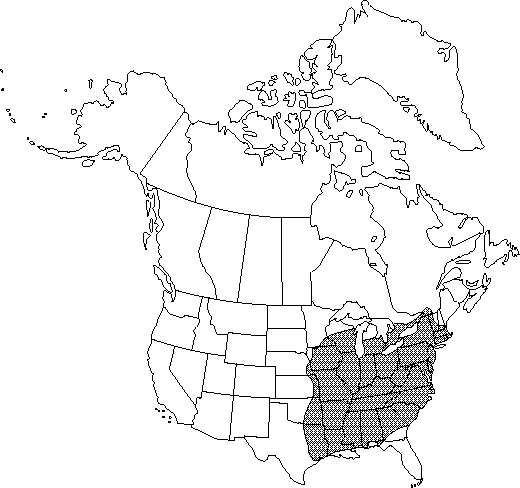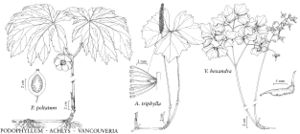Podophyllum peltatum
Sp. Pl. 1: 505. 1753.
Rhizomes: annual elongation increments (2-) 6-20 cm. Leaves of nonflowering shoots 2-5 dm; blade 18-38 × 18-38 cm. Flowering shoots 3-6 dm; leaves nearly opposite, slightly unequal in size; petioles 5-15 cm; proximal blades 10-35 × 14-40 cm, distal blades 6-25 × 10-33 cm. Leaf-blades 5-7 (-9) -parted, parts lobed or not (frequently 2-lobed), margins entire or coarsely dentate, teeth apiculate; surfaces abaxially sparsely pubescent to glabrous. Flowers solitary, nodding, fragrant; peduncle arising from angle between petioles, 1.5-6 cm; sepals orbiculate, 10-18 × 10-18 mm; petals white, rarely pink, obovate, 15-35 × 10-25 mm; stamens 2 times number of petals, 8-13 mm; filaments 3-5 mm; anthers 5-8 × 1-1.5 mm; ovaries 6-12 × 4-8 mm; style 1-2 mm; stigmas 3-6 mm. Berries yellow, rarely orange or maroon, 3.5-5.5 × 2.0-4 cm. Seeds 30-50, ovoid, 6-8 × 4-6 mm. 2n = 12.
Phenology: Flowering spring, fruiting late spring–summer; summer deciduous.
Habitat: Mixed deciduous forest, fields, moist road banks, river banks
Elevation: 50-800 m
Distribution

Ont., Que., Ala., Ark., Conn., Del., D.C., Fla., Ga., Ill., Ind., Iowa, Kans., Ky., La., Md., Mass., Mich., Minn., Miss., Mo., Nebr., N.H., N.J., N.Y., N.C., Ohio, Okla., Pa., R.I., S.C., Tenn., Tex., Vt., Va., W.Va., Wis.
Discussion
The following forms have been described:
Podophyllum peltatum forma aphyllum Plitt–fertile shoots with no foliage leaves; Podophyllum peltatum forma biltmoreanum Steyermark–fruits orange; Podophyllum peltatum forma deamii Raymond–fruits and seeds maroon, and flowers, placentae, and plant axes pink-tinged; Podophyllum peltatum forma polycarpum (Clute) Plitt–flowers with multiple, free carpels.
The ripe fruit of Podophyllum peltatum is considered edible; all other parts of the plant are toxic. Several lignans and their glycosides, present in the resin extracted from rhizomes and roots, exhibit antitumor activity. Etoposide, a semisynthetic derivative of one of the lignans, is currently used in the treatment of small-cell lung cancer and testicular cancer (P. M. Dewick 1983). Native Americans used Podophyllum for a wide variety of medicinal purposes and as an insecticide (D. E. Moerman 1986).
Podophyllum peltatum is sometimes cultivated in woodland gardens, and some populations on the periphery of its geographical range may be escapes from cultivation.
Selected References
None.
Lower Taxa
"dm" is not declared as a valid unit of measurement for this property.
